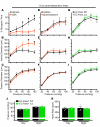Endothelial cell Pannexin1 modulates severity of ischemic stroke by regulating cerebral inflammation and myogenic tone
- PMID: 29563335
- PMCID: PMC5926909
- DOI: 10.1172/jci.insight.96272
Endothelial cell Pannexin1 modulates severity of ischemic stroke by regulating cerebral inflammation and myogenic tone
Abstract
Ischemic stroke is a leading cause of morbidity and mortality in the US; however, there currently exists only one effective acute pharmacological therapeutic intervention. Purinergic signaling has been shown to regulate vascular function and pathological processes, including inflammation and arterial myogenic reactivity, and plays a role in ischemic stroke outcome. Purinergic signaling requires extracellular purines; however, the mechanism of purine release from cells is unclear. Pannexin1 (Panx1) channels are potentially novel purine release channels expressed throughout the vascular tree that couples regulated purine release with purinergic signaling. Therefore, we examined the role of smooth muscle and endothelial cell Panx1, using conditional cell type-specific transgenic mice, in cerebral ischemia/reperfusion injury outcomes. Deletion of endothelial cell Panx1, but not smooth muscle cell Panx1, significantly reduced cerebral infarct volume after ischemia/reperfusion. Infiltration of leukocytes into brain tissue and development of cerebral myogenic tone were both significantly reduced when mice lacked endothelial Panx1. Panx1 regulation of myogenic tone was unique to the cerebral circulation, as mesenteric myogenic reactivity and blood pressure were independent of endothelial Panx1. Overall, deletion of endothelial Panx1 mitigated cerebral ischemic injury by reducing inflammation and myogenic tone development, indicating that endothelial Panx1 is a possible novel target for therapeutic intervention of ischemic stroke.
Keywords: Mouse models; Neuroscience; Stroke.
Conflict of interest statement
Figures






Similar articles
-
Pannexin-1 channels on endothelial cells mediate vascular inflammation during lung ischemia-reperfusion injury.Am J Physiol Lung Cell Mol Physiol. 2018 Aug 1;315(2):L301-L312. doi: 10.1152/ajplung.00004.2018. Epub 2018 May 10. Am J Physiol Lung Cell Mol Physiol. 2018. PMID: 29745255 Free PMC article.
-
Pannexin1 knockout and blockade reduces ischemic stroke injury in female, but not in male mice.Oncotarget. 2017 Jun 6;8(23):36973-36983. doi: 10.18632/oncotarget.16937. Oncotarget. 2017. PMID: 28445139 Free PMC article.
-
Epithelial and Endothelial Pannexin1 Channels Mediate AKI.J Am Soc Nephrol. 2018 Jul;29(7):1887-1899. doi: 10.1681/ASN.2017121306. Epub 2018 Jun 4. J Am Soc Nephrol. 2018. PMID: 29866797 Free PMC article.
-
Pannexin1 Channel-Mediated Inflammation in Acute Ischemic Stroke.Aging Dis. 2024 May 7;15(3):1296-1307. doi: 10.14336/AD.2023.0303. Aging Dis. 2024. PMID: 37196132 Free PMC article. Review.
-
Myogenic tone as a therapeutic target for ischemic stroke.Curr Vasc Pharmacol. 2014;12(6):788-800. doi: 10.2174/15701611113116660155. Curr Vasc Pharmacol. 2014. PMID: 24066932 Review.
Cited by
-
Endothelial Pannexin 1 Regulates Cardiac Response to Myocardial Infarction.Circ Res. 2021 Apr 16;128(8):1211-1213. doi: 10.1161/CIRCRESAHA.120.317272. Epub 2021 Mar 1. Circ Res. 2021. PMID: 33641341 Free PMC article. No abstract available.
-
Altered Expression of Ion Channels in White Matter Lesions of Progressive Multiple Sclerosis: What Do We Know About Their Function?Front Cell Neurosci. 2021 Jun 25;15:685703. doi: 10.3389/fncel.2021.685703. eCollection 2021. Front Cell Neurosci. 2021. PMID: 34276310 Free PMC article. Review.
-
Myeloid Pannexin-1 mediates acute leukocyte infiltration and leads to worse outcomes after brain trauma.J Neuroinflammation. 2020 Aug 20;17(1):245. doi: 10.1186/s12974-020-01917-y. J Neuroinflammation. 2020. PMID: 32819386 Free PMC article.
-
Therapeutic strategies targeting connexins.Nat Rev Drug Discov. 2018 Dec;17(12):905-921. doi: 10.1038/nrd.2018.138. Epub 2018 Oct 12. Nat Rev Drug Discov. 2018. PMID: 30310236 Free PMC article. Review.
-
Animal Models of Ischemic Stroke with Different Forms of Middle Cerebral Artery Occlusion.Brain Sci. 2023 Jun 29;13(7):1007. doi: 10.3390/brainsci13071007. Brain Sci. 2023. PMID: 37508939 Free PMC article. Review.
References
Publication types
MeSH terms
Substances
Grants and funding
LinkOut - more resources
Full Text Sources
Other Literature Sources
Medical
Molecular Biology Databases

